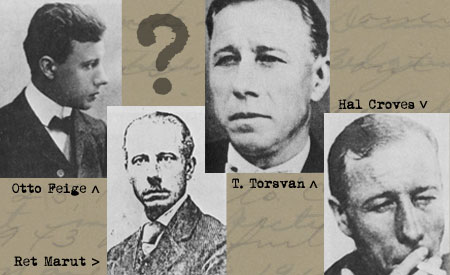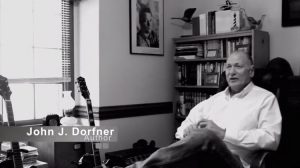“An author should have no other biography than his books.”
“The biography of a creative man is completely unimportant.”
– B. Traven
Warner Brothers bought the novel THE TREASURE OF THE SIERRA MADRE in 1941 with John Huston in mind as director. When the studio wrote the author, a Mr. B. Traven, in Mexico City suggesting that they pay him to come to Los Angeles to work with Huston on adapting the book into a screenplay they received a curious response. Traven wrote back suggesting that for him to travel to L. A. would be a most imprudent use of their funds. He explained that his health deteriorated anytime he left the tropics. He went on to say that Huston was so focused on getting a great performance from Ms. Bette Davis in his current picture that he would not have time to devote to adapting the book. He was right. At any rate, two days later the Japanese bombed Pearl Harbor which upended every one’s schedule. John Huston spent the next few years flying in and out of combat zones, shooting Army and Air Force films for the Pentagon.

When John Huston prepared to leave for Mexico in January 1947 to scout locations and meet the elusive writer of THE TREASURE OF THE SIERRA MADRE he felt he was on the cusp of another great adventure. Huston would be visiting some of the most beautiful wilderness in Mexico and if he had his way he would also have time to hook into a marlin off the coast of Acapulco. He had hooked one near Catalina once but had lost the magnificent creature when the leader broke. Huston also felt sure he would be able to solve the mystery that was B. Traven. The author’s reclusiveness had already fueled his popularity around the world. ** “No one claimed to have seen him, no one even knew his nationality. It was speculated that he was actually Jack London or Ambrose Bierce or the illegitimate son of Kaiser Wilhelm II. Not even Paul Kohner, who acted as Traven’s movie agent, had ever met his client. Kohner piqued Huston’s interest when he related the difficulties he had in securing the rights to Traven’s work by first going to see his publisher in Switzerland and then traveling to Mexico with his wife, Lupita, whom Traven had loved from a distance before she married, when she was a well known Mexican actress. Traven had followed Lupita Tovar’s career, had saved clippings about her, had even, he claimed, once danced with her in Guadalajara years earlier.”

“So when Huston heard from Traven saying that he would meet him in Mexico City, John felt that he was about to unravel a mystery.” Traven had also written to Huston that he approved of Huston’s script and he felt Bogart was perfect as Dobbs. By this point Traven and Huston had exchanged a number of letters and Huston had also read Traven’s script based on his book THE BRIDGE IN THE JUNGLE. Based on these exchanges Huston had come to find the man both fascinating and extremely talented. It was with all this in mind that Huston arrived at the Hotel Bamer in Mexico City to finally meet B. Traven. The appointed time came and went Traven did not show. Huston takes over here. * “One morning almost a week after my arrival I woke shortly after daybreak to discover a man standing at the foot of my bed. He took out a card which read: HAL CROVES ~~ TRANSLATOR, ACAPULCO AND SAN ANTONIO. He then produced a letter from B. Traven, which I read while I was still in bed. It said that Croves was authorized to answer any questions I might want to ask. Whatever advice Croves gave me would be just as good as if it came from Traven himself. So I arranged to see Croves later in the day. During that meeting we talked about the TREASURE script in great detail. He had read it carefully and approved it completely. Croves had a slight accent. It didn’t sound German to me but certainly European. I thought he might very well be Traven, but out of delicacy I didn’t ask. On the other hand, Croves gave an impression quite unlike the one I had formed of Traven from reading his scripts and correspondence. Croves was very tight and guarded in his manner of speaking. He was nothing at all as I had imagined, and after two meetings I had decided that this was surely not he.”
“Croves was a small, thin man with a long nose. His eyes were quite blue and close together, and he had graying blond hair. His trousers were peg topped, he wore a big hat and had a handkerchief tied around his neck, inside the shirt collar. He had kind of a boxback jacket on, and was wearing wide suspenders. All in all, he looked as if he were country born and bred, unfamiliar with the ways of the city. Croves went off to Acapulco after our meetings, and a few days later I joined him there along with my wife, Evelyn and Paulette Goddard. In Acapulco he was dressed in the same clothes minus the jacket.” Since they were going to be there anyway Huston decided this was his chance to get his marlin. Croves insisted he knew all about marlin fishing and he went along with them. Huston, like his wife had no luck. Croves hooked one and after it broke water and danced for fifty yards Huston decided it was the “biggest God-Damned marlin I had ever seen.” Croves quickly showed his ignorance by snarling the line then dropping the rod, losing the marlin. Huston explains what happened next.
* “On the return trip Evelyn and I each caught a sailfish–pretty dull fishing compared to the marlin, but Evelyn insisted that the three of us pose with our catch once we got back to the dock. As the photographer snapped the picture Croves turned his face away from the camera. I had the distinct impression this was done for my benefit. It was to make me think he wished to keep his existence a secret from the outer world. The implication, of course, was that he was B. Traven. I wasn’t particularly concerned about his identity. I was more interested in the fact that the man obviously knew Traven’s work–and Mexico–well and could be a help to us as an advisor. He agreed to this, and I returned to Hollywood to start production.”
Huston had more pressing things to keep him occupied. THE TREASURE OF THE SIERRA MADRE was one of the first American films to be shot entirely on location outside the United States. The start of the shoot was plagued by typical location problems, not the least of which was the fact that the producers had failed to pay the proper ‘mordida’ to the newspaper editor and other officials. After a considerable delay pay offs were made and production resumed. Croves performed as requested for the duration of production but along the way Huston became totally convinced that he was not the mysterious B. Traven. After the film came out the mystery became a matter of public controversy.
* “Everyone was talking about the B. Traven mystery. In 1948 a Mexican magazine sent two reporters to shadow Croves in an attempt to ascertain the facts. They found him keeping a small store on the edge of the jungle near Acapulco. They  watched his store until Croves left to go into town, then they broke in and rifled his desk. In the desk were several B. Traven manuscripts and evidence that Croves had another name. Traven Torsvan. Hal Croves and Traven were apparently the same man, after all. Subsequent investigations have uncovered evidence of yet a fourth name. Ret Marut, an anti-war anarchist writer who disappeared from Germany in 1922. In 1923 B. Traven appeared in Mexico, and various experts have testified from examining the writing style of these two men that there is little doubt that they are one and the same….. Croves died in 1969, some years after marrying his assistant, Rose Elana Lujan. A month after his death his widow confirmed that B. Traven had been Rex Marut.”
watched his store until Croves left to go into town, then they broke in and rifled his desk. In the desk were several B. Traven manuscripts and evidence that Croves had another name. Traven Torsvan. Hal Croves and Traven were apparently the same man, after all. Subsequent investigations have uncovered evidence of yet a fourth name. Ret Marut, an anti-war anarchist writer who disappeared from Germany in 1922. In 1923 B. Traven appeared in Mexico, and various experts have testified from examining the writing style of these two men that there is little doubt that they are one and the same….. Croves died in 1969, some years after marrying his assistant, Rose Elana Lujan. A month after his death his widow confirmed that B. Traven had been Rex Marut.”
B Traven, Ret Marut, Traven Torsvan, Hal Croves all the same man? In the seventies a great deal of research was done by a very reputable filmmaker who produced a documentary and a book on the Traven mystery. He concluded that this man B. Traven had started life as Otto Feige who was born into a Polish village which became a German territory in the war. Feige had been a political dissident writer protesting the Germans. He wrote under the name Rex Marut and was forced to flee to London and then to Mexico. Later biographers have disputed this account and insist that if anything Traven at best may have picked up Feiges identity for a while. Travenologists sixty five years later, continue to debate the facts. At any given time you can find a lively debate about Traven’s true identity on the Internet. For my money I tend to put the most credence in the man who actually spent time with Traven….I mean Croves.
Huston had this to say. * “I believe that B. Traven was two or more persons who worked in collaboration. Many have questioned how Ret Marut could have left Germany in 1922, and three and a half years later offered three novels to the world that did not deal at all with German social and poltical affairs—his specialty—but, instead, probed the experiences of an American, Gerard Gales, in western Europe, at sea and in Mexico: THE DEATH SHIP, THE COTTON PICKERS and THE BRIDGE IN THE JUNGLE. Hal Croves could certainly have had those experiences, but hardly Ret Marut.” (I’m sure the writers reading this would agree.)
Huston continues. “I met Hal Croves step daughter in Mexico after Croves died. We talked about him at some length. I was amazed at her description of the man: urbane, sociable, impeccably dressed; of an eminence in Mexico City. She recalled dinners in the Croves household as formal occasions even when there were no guests present. All of this bears little resemblance to the reticent little man who stood at the foot of my bed years ago in Mexico City with his wide suspenders and ‘country boy’ clothes. A complete transformation? An attempt to live up to his–or someone elses–image of a famous author? Interesting speculation.”
References:
* An Open Book by John Huston Knopf, c1980
** THE HUSTONS by Lawrence Grobel Charles Scribner’s sons, c1989




Leave a Reply